选择性必修第三册Unit 2 Healthy Lifestyle Reading and Thinking(课件)
文档属性
| 名称 | 选择性必修第三册Unit 2 Healthy Lifestyle Reading and Thinking(课件) | 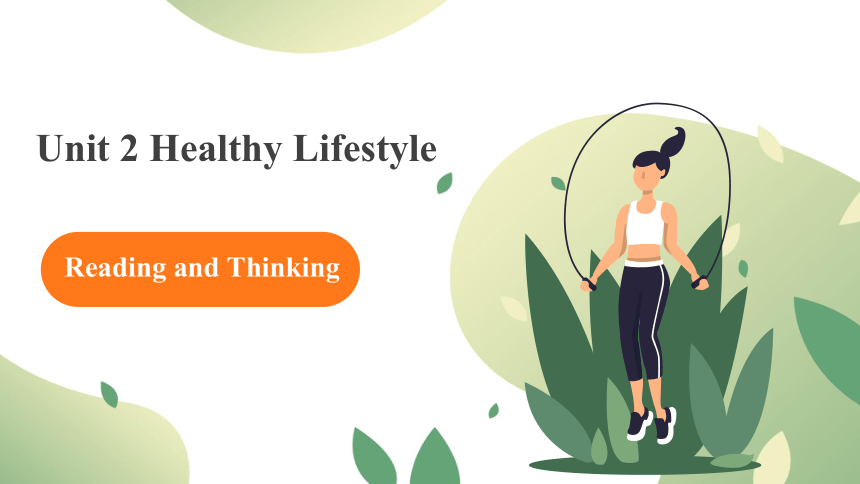 | |
| 格式 | zip | ||
| 文件大小 | 60.2MB | ||
| 资源类型 | 试卷 | ||
| 版本资源 | 人教版(2019) | ||
| 科目 | 英语 | ||
| 更新时间 | 2023-03-06 17:02:33 | ||
图片预览

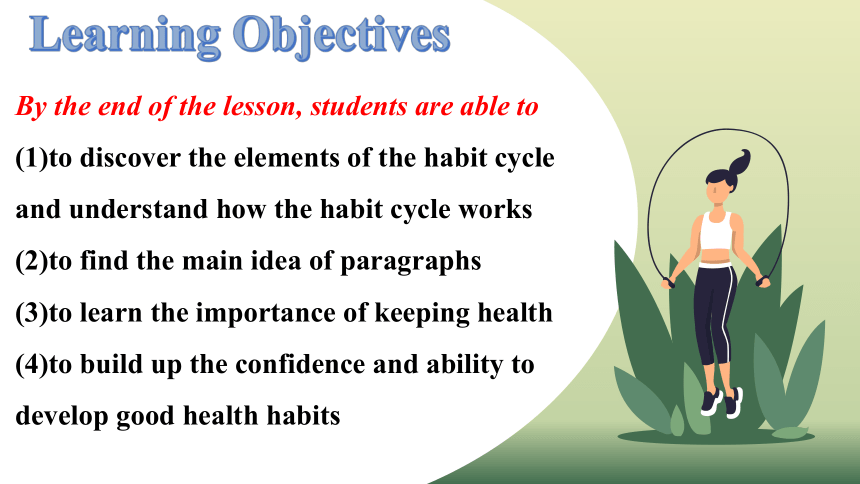
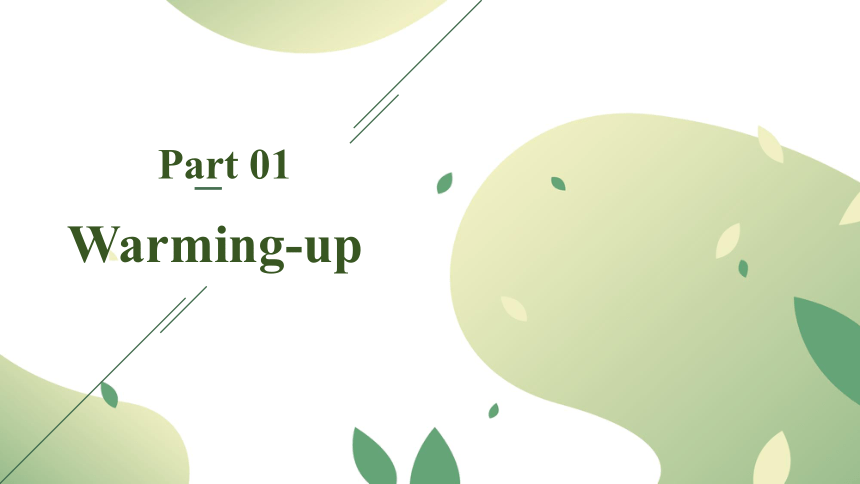
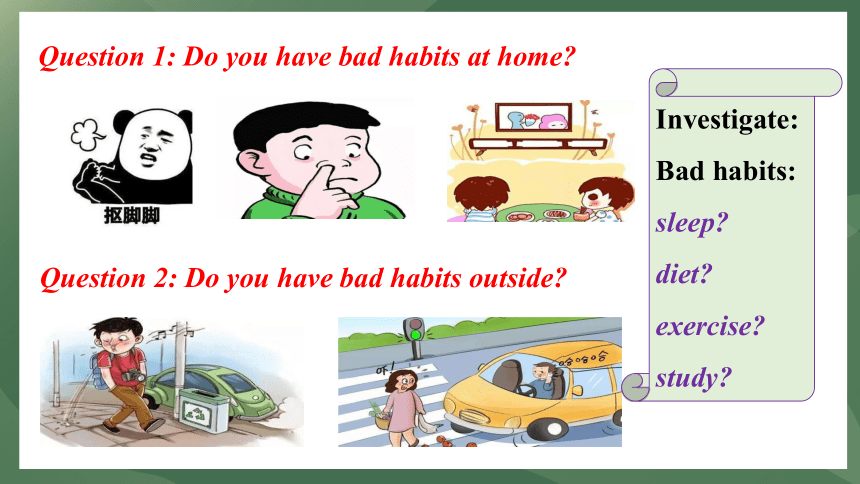
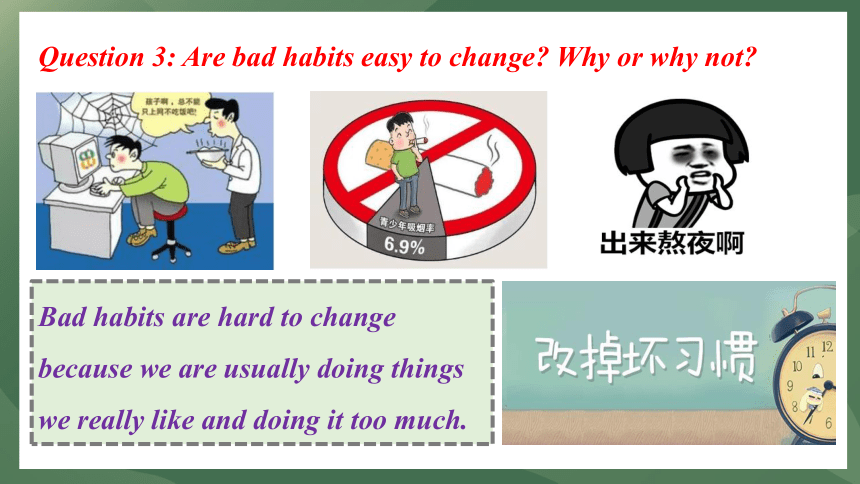
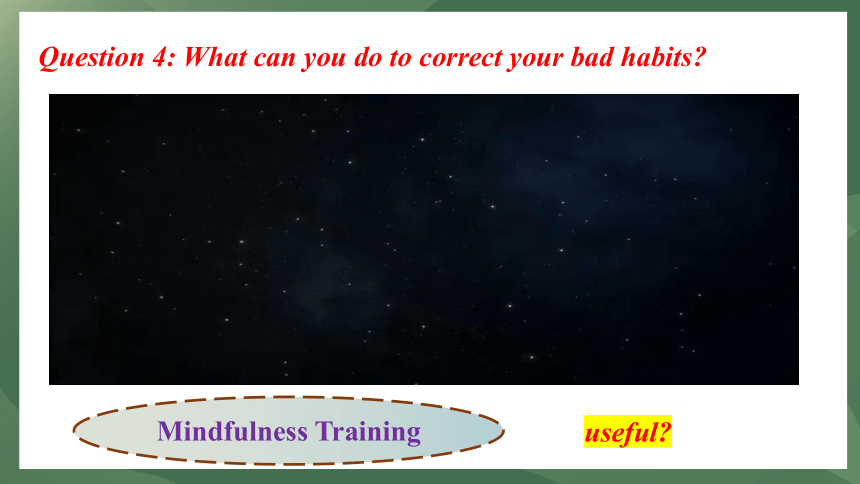
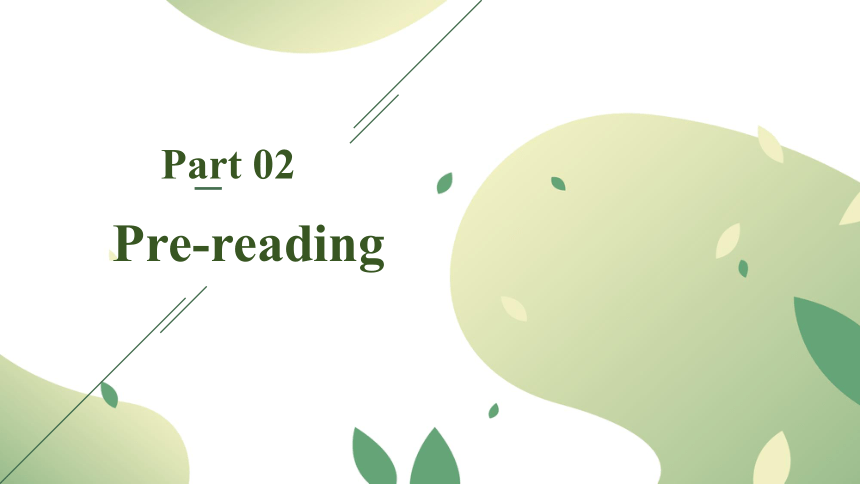
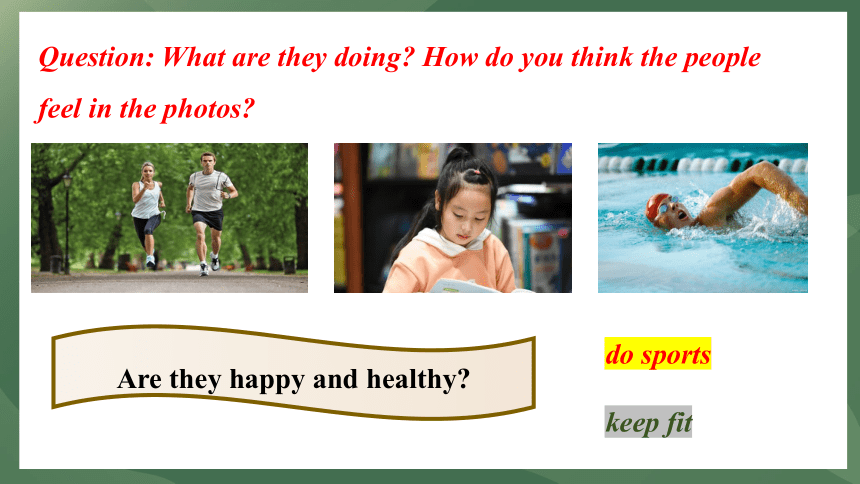
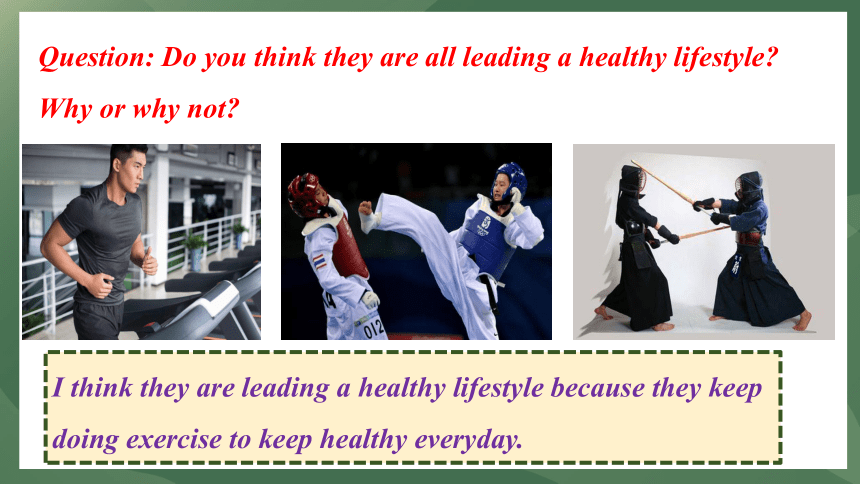
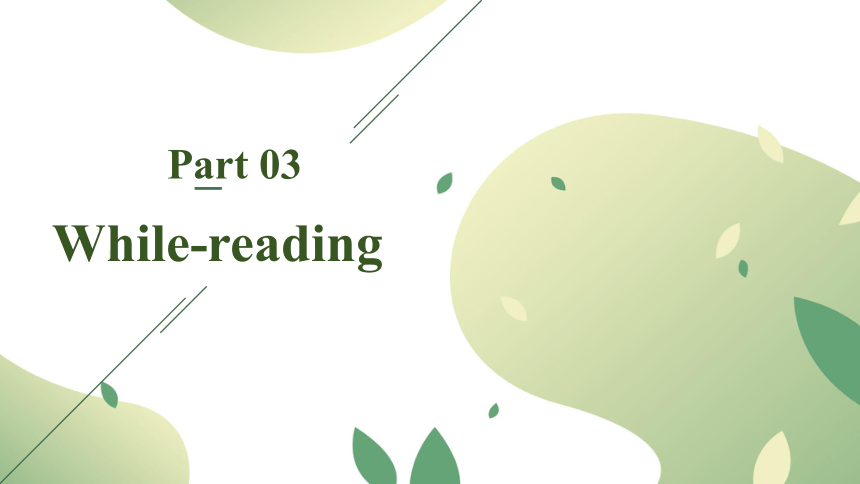

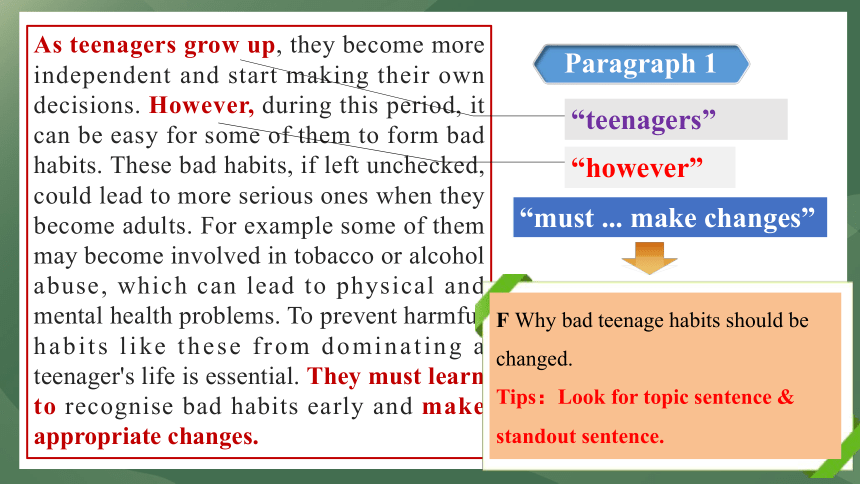
文档简介
(共45张PPT)
Unit 2 Healthy Lifestyle
Reading and Thinking
Learning Objectives
By the end of the lesson, students are able to
(1)to discover the elements of the habit cycle and understand how the habit cycle works
(2)to find the main idea of paragraphs
(3)to learn the importance of keeping health
(4)to build up the confidence and ability to develop good health habits
Part 01
Warming-up
Question 1: Do you have bad habits at home
Question 2: Do you have bad habits outside
Investigate:
Bad habits:
sleep
diet
exercise
study
Question 3: Are bad habits easy to change Why or why not
Bad habits are hard to change because we are usually doing things we really like and doing it too much.
Question 4: What can you do to correct your bad habits
Mindfulness Training
useful
Part 02
Pre-reading
Question: What are they doing How do you think the people feel in the photos
Are they happy and healthy
do sports
keep fit
Question: Do you think they are all leading a healthy lifestyle Why or why not
I think they are leading a healthy lifestyle because they keep doing exercise to keep healthy everyday.
Part 03
While-reading
Scanning:
Read the text and find out what main ideas are included in it. Tick the correct ones.
A. How to change a bad habit and create good ones
The cycle of how habits are formed
Habits that can help us study better
Changing habits gradually
No easy way to change bad habits
What a habit is
Why bad teenage habits should be changed
Para. ___
Para. ___
Para. ___
Para. ___
Para. ___
Para. ___
Para. ___
As teenagers grow up, they become more independent and start making their own decisions. However, during this period, it can be easy for some of them to form bad habits. These bad habits, if left unchecked, could lead to more serious ones when they become adults. For example some of them may become involved in tobacco or alcohol abuse, which can lead to physical and mental health problems. To prevent harmful habits like these from dominating a teenager's life is essential. They must learn to recognise bad habits early and make appropriate changes.
“teenagers”
“however”
“must ... make changes”
Paragraph 1
F Why bad teenage habits should be changed.
Tips:Look for topic sentence & standout sentence.
Paragraph 2
To change bad habits is never easy, even with many attempts. There is a famous saying based on the philosophy of Aristotle: “We are what we repeatedly do.” In many ways, our lifestyle is the sum of choices we have made. We make a choice to do something, and then we repeat it over and over again. Soon that choice becomes automatic and forms a habit that is much harder to change. The good news is that we can change, if we understand how habits work.
E What a habit is and to change habits is not easy
Tips:Look for topic sentence
Topic sentence
Leading to the next paragraph
Paragraph 3-4
According to modern psychology, we must first learn about the “habit cycle”, which works like this:
Firstly, there is “cue”, an action, event, or situation that acts as a signal to do something.
Secondly, there is a “routine”, the regular action you take in response to the cue.
Thirdly, there is a “reward”, the good thing or feeling we get from the routine.
For example, when we feel unhappy (cue), we eat lots of unhealthy snacks (routine), which makes us feel happy (reward) The reward makes us much more likely to continue the cycle, and the bad habit of relying on unhealthy snacks is formed.
Topic sentence
B The cycle of how habits are formed
Tips:Look for topic sentence
To facilitate a positive change in our bad habits, we must first examine our bad habit cycles and then try to adapt them. We can do this by combining the information from our habit cycles with our own positive ideas. For example, we could try to replace a negative routine with something more positive. So, when we feel unhappy again (cue), rather than eat snacks, we could listen to some of our favourite music instead (routine), which will make us feel relaxed (reward). Aside from changing bad habits, we can also use the habit cycle to create good habits. For example, when we come to an escalator(cue), our normal routine is to ride it, but we could change this routine into something more positive by taking the stairs instead.
Paragraph 5
Topic sentence
Standout sentence
A How to change a bad habit and create good ones
Tips:Look for topic sentence & standout sentence.
Many of us try to change bad habits quickly and if we are not successful straight away, we often become pessimistic and give up. In fact, the most successful way to change is not suddenly, but over a period of time. As the Chinese philosopher Lao Zi wrote, “A journey of a thousand miles begins with a single step. "One step seems small, but it is essential. To reach the goal of change, a person must show some discipline and repeatedly take many small steps. After all, it is not easy to break bad habits .
Paragraph 6
Standout sentence
D Changing habits gradually.
Tips:Look for standout sentence.
For young people, there is plenty of time to change bad habits. However, there is no"magic pill" or delete button that will help you; you have to think about your bad habits and decide on some changes. You have the power to build a happy and healthy life full of good habits!
Paragraph 7
C Young people have the power to build a healthy life full of good habits.
Tips:Look for topic sentence
“young people”
Topic sentence
Scanning:
Read the text and find out what main ideas are included in it. Tick the correct ones.
A. How to change a bad habit and create good ones
The cycle of how habits are formed
Habits that can help us study better
Changing habits gradually
No easy way to change bad habits
What a habit is
Why bad teenage habits should be changed
Para. ___
Para. ___
Para. ___
Para. ___
Para. ___
Para. ___
Para. ___
5
3-4
6-7
2
2
1
√
√
√
√
√
√
Scanning:
Read again and think: How many parts can the whole passage be divided into
Why bad habits should be changed
What a habit is
The cycle of what habits are formed
How to change a bad habit and create a good one
Changing habits gradually
No easy way to change bad habits
Scanning:
Read again and think: How many parts can the whole passage be divided into
The structure of this passage
Why bad teenage habits should be changed (Para. 1)
What a habit is and how to change bad habits (Para. 2 ~ 5)
No easy way to change bad habits (Para. 6)
(Why, What, How)
Scanning:
Read again and think:
Why did the writer write this text
To explain a teenage problem and suggest possible solutions.
Who’s the intended reader How can you tell
The intended readers are young people, especially teenagers. The first paragraph mainly discusses why it is easy for teenagers to form bad habits. The last paragraph starts with“For young people..."and"you"is used to address the reader.
Skimming:
Para. 1
As teenagers grow up, they become more independent and start making their own decisions. However, during this period, it can be easy for some of them to form bad habits. These bad habits, if left unchecked, could lead to more serious ones when they become adults. For example some of them may become involved in tobacco or alcohol abuse, which can lead to physical and mental health problems. To prevent harmful habits like these from dominating a teenager's life is essential. They must learn to recognise bad habits early and make appropriate changes.
Question 1: Why bad habits should be changed
Question 2: What should teenagers do to recognize the bad habits
Skimming:
Para. 1
As teenagers grow up, they become more independent and start making their own decisions. However, during this period, it can be easy for some of them to form bad habits. These bad habits, if left unchecked, could lead to more serious ones when they become adults. For example some of them may become involved in tobacco or alcohol abuse, which can lead to physical and mental health problems. To prevent harmful habits like these from dominating a teenager's life is essential. They must learn to recognise bad habits early and make appropriate changes.
Question 3: How does the author develop the paragraph
By giving examples.
Skimming:
Para. 2
To change bad habits is never easy, even with many attempts. There is a famous saying based on the philosophy of Aristotle: “We are what we repeatedly do.” In many ways, our lifestyle is the sum of choices we have made. We make a choice to do something, and then we repeat it over and over again. Soon that choice becomes automatic and forms a habit that is much harder to change. The good news is that we can change, if we understand how habits work.
Question 1: How can a choice lead to a habit
Skimming:
Para. 2
To change bad habits is never easy, even with many attempts. There is a famous saying based on the philosophy of Aristotle: “We are what we repeatedly do.” In many ways, our lifestyle is the sum of choices we have made. We make a choice to do something, and then we repeat it over and over again. Soon that choice becomes automatic and forms a habit that is much harder to change. The good news is that we can change, if we understand how habits work.
Question 2: How does the author develop the paragraph
By directly quoting.
Skimming:
Para. 3-4
According to modern psychology, we must first learn about the “habit cycle”, which works like this:
Firstly, there is “cue”, an action, event, or situation that acts as a signal to do something.
Secondly, there is a “routine”, the regular action you take in response to the cue.
Thirdly, there is a “reward”, the good thing or feeling we get from the routine.
For example, when we feel unhappy (cue), we eat lots of unhealthy snacks (routine), which makes us feel happy (reward)
Question 1: What is the three stages of habit cycle and what are they refer to
Skimming: Para. 3-4
According to modern psychology, we must first learn about the “habit cycle”, which works like this:
Firstly, there is “cue”, an action, event, or situation that acts as a signal to do something.
Secondly, there is a “routine”, the regular action you take in response to the cue.
Thirdly, there is a “reward”, the good thing or feeling we get from the routine.
For example, when we feel unhappy (cue), we eat lots of unhealthy snacks (routine), which makes us feel happy (reward)
Question 2: How does the author develop the paragraph
By giving definitions and examples.
To facilitate a positive change in our bad habits, we must first examine our bad habit cycles and then try to adapt them. We can do this by combining the information from our habit cycles with our own positive ideas. For example, we could try to replace a negative routine with something more positive. So, when we feel unhappy again (cue), rather than eat snacks, we could listen to some of our favourite music instead (routine), which will make us feel relaxed (reward). Aside from changing bad habits, we can also use the habit cycle to create good habits. For example, when we come to an escalator(cue), our normal routine is to ride it, but we could change this routine into something more positive by taking the stairs instead.
Skimming:
Para. 5
Question 1: How can a person use discipline to help change a bad habit
Question 2: How can we combine the information from our habit cycles with our own positive ideas Use a table to show it.
Skimming:
Para. 5(Group discussion)
The Habit Cycle Bad Habit New Habit
Cue feel happy
Routine
Reward feel happier but it’s not healthy
Question 2: How can we combine the information from our habit cycles with our own positive ideas Use a table to show it.
The Habit Cycle Bad Habit New Habit
Cue finished lunch finish lunch
Routine went back to the office and went to bed immediately go to the playground and walk for 10 minutes
Reward feel relaxed but worried about its bad effect on health feel relaxed and healthier
To facilitate a positive change in our bad habits, we must first examine our bad habit cycles and then try to adapt them. We can do this by combining the information from our habit cycles with our own positive ideas. For example, we could try to replace a negative routine with something more positive. So, when we feel unhappy again (cue), rather than eat snacks, we could listen to some of our favourite music instead (routine), which will make us feel relaxed (reward). Aside from changing bad habits, we can also use the habit cycle to create good habits. For example, when we come to an escalator(cue), our normal routine is to ride it, but we could change this routine into something more positive by taking the stairs instead.
Skimming: Para. 5
Question 3: How does the author develop the paragraph
By giving examples.
Skimming:
Para. 6
Many of us try to change bad habits quickly and if we are not successful straight away, we often become pessimistic and give up. In fact, the most successful way to change is not suddenly, but over a period of time. As the Chinese philosopher Lao Zi wrote, “A journey of a thousand miles begins with a single step. "One step seems small, but it is essential. To reach the goal of change, a person must show some discipline and repeatedly take many small steps. After all, it is not easy to break bad habits .
Question 1: Do you think we can change the bad habits immediately
Question 2: How can we reach the goal of changing bad habits
Skimming:
Para. 6
Many of us try to change bad habits quickly and if we are not successful straight away, we often become pessimistic and give up. In fact, the most successful way to change is not suddenly, but over a period of time. As the Chinese philosopher Lao Zi wrote, “A journey of a thousand miles begins with a single step. "One step seems small, but it is essential. To reach the goal of change, a person must show some discipline and repeatedly take many small steps. After all, it is not easy to break bad habits .
Question 3: How does the author develop the paragraph
By directly quoting.
Language Points:
1. Secondly,there is a “routine”,the regular action you take in response to the cue.
Note: in response to=respond to回复,回应
例:针对青少年滥用烟草,我们必须采取一些有效措施帮助他们摆脱这种习惯。
In response to teenagers’ abuse of tobacco,we must take some effective measures to help them get rid of it.
=Responding to teenagers’ abuse of tobacco,we must take some effective measures to help them get rid of it.
Language Points:
2. These bad habits,if left unchecked,could lead to more serious ones when they become adults.
Note: 在if引导的条件状语从句中,如果从句的主语和主句的主语一致,同时从句谓语动词含有 be 动词,则可省略从句的主语和 be动词。
if left unchecked=if it is left unchecked
if省略的固定结构:
if necessary / possible 如果必要的话 / 如果可能的话
if not 不然 if so 如果是这样的话
Language Points:
3. There is a famous saying based on the philosophy of Aristotle:“We are what we repeatedly do.”
Note: 过去分词短语作定语,与被修饰词之间为被动关系,相当于定语从句的省略
There is a famous saying based on the philosophy of Aristotle
=There is a famous saying which is based on the philosophy of Aristotle
All of the students think highly of the after-class activity held last Saturday.
=All of the students think highly of the after-class activity which was held last Saturday.
Language Points:
4. The reward makes us much more likely to continue the cycle,and the bad habit of relying on unhealthy snacks is formed.
Note: in reward for作为......的回报、奖赏
rely on sb. to do/doing sth. 依靠/指望某人做某事
例:我想做点什么来报答她的好意。
I would like to do something in reward for her kindness.
我保证你可以依靠他帮助你摆脱困难。
I guarantee that you can rely on him to help you out of difficulty.
Language Points:
5. As the Chinese philosopher Lao Zi wrote, “ A journey of a thousand miles begins with a single step.”
Note: 写作中引用格言的表达方式:
(1) As an old saying goes like this, ...
(2) Just as ... highly puts it, ...
(3) There goes a saying that..., which is put by ...
(4)According to..., a renowned philosopher in ancient ..., ...
(5)... once said, the quote ...
Language Points:
6. Many of us try to change bad habits quickly,and if we are not successful straight away,we often become pessimistic and give up.
Note: straight away=right away=right now=at once=in no time=immediately立即;马上
be pessimistic about对……悲观
例如:我看到成绩后非常悲观,弟弟立即跑过来安慰我。
Being pessimistic about my results, my brother came to my assistance straight away/right away/right now/at once/in no time/immediately.
Language Points:
7. After all,it is not easy to break bad habits.
Note: after all毕竟,终究
all的短语:
all in all总而言之
above all最重要的是
first of all=first and foremost首先
in all总共
not...at all 根本不,一点也不
Language Points:
8. You have to think about your bad habits and decide on some changes.
Note: decide on sth=decide to do sth=make a decision to do sth 决定做某事
arrive at/come to/reach a decision做出决定
例如:你们定好婚礼日期了吗?
Have you decided on/decide to make/make a decision to make a date for the wedding
他们花了很长时间才做出了一个艰难的决定。
It took them a long time to arrive at/come to/reach a decision.
Part 04
Post-reading
There are two posts from two students. If you are their friend, could you please help them
Post 1:I have been suffering from the bad habit of overeating for decades. Every time I feel upset, I eat a lot. Overeating is the most effective way for me to relievestress temporarily. It is ironic that I eat even more when I feel anxious about gaining weight.I am overweight and frequently have a stomachache. What shall I do I really want to get rid of this terrible habit.
There are two posts from two students. If you are their friend, could you please help them
Post 2:My friends call me a night owl.I often stay up lateand go to bed after 2 a.m.When I am actually in bed, I still can't help playing with my cellphone for one houror more.In other words,I fall asleep later than 3 a.m. I feel dizzy from time to time.I find it hard to work efficiently at daytime. Sleeping late even makes my skin look bad.I know it is an unhealthy habit but I don't know what to do.
THANK YOU!
感谢聆听!
Unit 2 Healthy Lifestyle
Reading and Thinking
Learning Objectives
By the end of the lesson, students are able to
(1)to discover the elements of the habit cycle and understand how the habit cycle works
(2)to find the main idea of paragraphs
(3)to learn the importance of keeping health
(4)to build up the confidence and ability to develop good health habits
Part 01
Warming-up
Question 1: Do you have bad habits at home
Question 2: Do you have bad habits outside
Investigate:
Bad habits:
sleep
diet
exercise
study
Question 3: Are bad habits easy to change Why or why not
Bad habits are hard to change because we are usually doing things we really like and doing it too much.
Question 4: What can you do to correct your bad habits
Mindfulness Training
useful
Part 02
Pre-reading
Question: What are they doing How do you think the people feel in the photos
Are they happy and healthy
do sports
keep fit
Question: Do you think they are all leading a healthy lifestyle Why or why not
I think they are leading a healthy lifestyle because they keep doing exercise to keep healthy everyday.
Part 03
While-reading
Scanning:
Read the text and find out what main ideas are included in it. Tick the correct ones.
A. How to change a bad habit and create good ones
The cycle of how habits are formed
Habits that can help us study better
Changing habits gradually
No easy way to change bad habits
What a habit is
Why bad teenage habits should be changed
Para. ___
Para. ___
Para. ___
Para. ___
Para. ___
Para. ___
Para. ___
As teenagers grow up, they become more independent and start making their own decisions. However, during this period, it can be easy for some of them to form bad habits. These bad habits, if left unchecked, could lead to more serious ones when they become adults. For example some of them may become involved in tobacco or alcohol abuse, which can lead to physical and mental health problems. To prevent harmful habits like these from dominating a teenager's life is essential. They must learn to recognise bad habits early and make appropriate changes.
“teenagers”
“however”
“must ... make changes”
Paragraph 1
F Why bad teenage habits should be changed.
Tips:Look for topic sentence & standout sentence.
Paragraph 2
To change bad habits is never easy, even with many attempts. There is a famous saying based on the philosophy of Aristotle: “We are what we repeatedly do.” In many ways, our lifestyle is the sum of choices we have made. We make a choice to do something, and then we repeat it over and over again. Soon that choice becomes automatic and forms a habit that is much harder to change. The good news is that we can change, if we understand how habits work.
E What a habit is and to change habits is not easy
Tips:Look for topic sentence
Topic sentence
Leading to the next paragraph
Paragraph 3-4
According to modern psychology, we must first learn about the “habit cycle”, which works like this:
Firstly, there is “cue”, an action, event, or situation that acts as a signal to do something.
Secondly, there is a “routine”, the regular action you take in response to the cue.
Thirdly, there is a “reward”, the good thing or feeling we get from the routine.
For example, when we feel unhappy (cue), we eat lots of unhealthy snacks (routine), which makes us feel happy (reward) The reward makes us much more likely to continue the cycle, and the bad habit of relying on unhealthy snacks is formed.
Topic sentence
B The cycle of how habits are formed
Tips:Look for topic sentence
To facilitate a positive change in our bad habits, we must first examine our bad habit cycles and then try to adapt them. We can do this by combining the information from our habit cycles with our own positive ideas. For example, we could try to replace a negative routine with something more positive. So, when we feel unhappy again (cue), rather than eat snacks, we could listen to some of our favourite music instead (routine), which will make us feel relaxed (reward). Aside from changing bad habits, we can also use the habit cycle to create good habits. For example, when we come to an escalator(cue), our normal routine is to ride it, but we could change this routine into something more positive by taking the stairs instead.
Paragraph 5
Topic sentence
Standout sentence
A How to change a bad habit and create good ones
Tips:Look for topic sentence & standout sentence.
Many of us try to change bad habits quickly and if we are not successful straight away, we often become pessimistic and give up. In fact, the most successful way to change is not suddenly, but over a period of time. As the Chinese philosopher Lao Zi wrote, “A journey of a thousand miles begins with a single step. "One step seems small, but it is essential. To reach the goal of change, a person must show some discipline and repeatedly take many small steps. After all, it is not easy to break bad habits .
Paragraph 6
Standout sentence
D Changing habits gradually.
Tips:Look for standout sentence.
For young people, there is plenty of time to change bad habits. However, there is no"magic pill" or delete button that will help you; you have to think about your bad habits and decide on some changes. You have the power to build a happy and healthy life full of good habits!
Paragraph 7
C Young people have the power to build a healthy life full of good habits.
Tips:Look for topic sentence
“young people”
Topic sentence
Scanning:
Read the text and find out what main ideas are included in it. Tick the correct ones.
A. How to change a bad habit and create good ones
The cycle of how habits are formed
Habits that can help us study better
Changing habits gradually
No easy way to change bad habits
What a habit is
Why bad teenage habits should be changed
Para. ___
Para. ___
Para. ___
Para. ___
Para. ___
Para. ___
Para. ___
5
3-4
6-7
2
2
1
√
√
√
√
√
√
Scanning:
Read again and think: How many parts can the whole passage be divided into
Why bad habits should be changed
What a habit is
The cycle of what habits are formed
How to change a bad habit and create a good one
Changing habits gradually
No easy way to change bad habits
Scanning:
Read again and think: How many parts can the whole passage be divided into
The structure of this passage
Why bad teenage habits should be changed (Para. 1)
What a habit is and how to change bad habits (Para. 2 ~ 5)
No easy way to change bad habits (Para. 6)
(Why, What, How)
Scanning:
Read again and think:
Why did the writer write this text
To explain a teenage problem and suggest possible solutions.
Who’s the intended reader How can you tell
The intended readers are young people, especially teenagers. The first paragraph mainly discusses why it is easy for teenagers to form bad habits. The last paragraph starts with“For young people..."and"you"is used to address the reader.
Skimming:
Para. 1
As teenagers grow up, they become more independent and start making their own decisions. However, during this period, it can be easy for some of them to form bad habits. These bad habits, if left unchecked, could lead to more serious ones when they become adults. For example some of them may become involved in tobacco or alcohol abuse, which can lead to physical and mental health problems. To prevent harmful habits like these from dominating a teenager's life is essential. They must learn to recognise bad habits early and make appropriate changes.
Question 1: Why bad habits should be changed
Question 2: What should teenagers do to recognize the bad habits
Skimming:
Para. 1
As teenagers grow up, they become more independent and start making their own decisions. However, during this period, it can be easy for some of them to form bad habits. These bad habits, if left unchecked, could lead to more serious ones when they become adults. For example some of them may become involved in tobacco or alcohol abuse, which can lead to physical and mental health problems. To prevent harmful habits like these from dominating a teenager's life is essential. They must learn to recognise bad habits early and make appropriate changes.
Question 3: How does the author develop the paragraph
By giving examples.
Skimming:
Para. 2
To change bad habits is never easy, even with many attempts. There is a famous saying based on the philosophy of Aristotle: “We are what we repeatedly do.” In many ways, our lifestyle is the sum of choices we have made. We make a choice to do something, and then we repeat it over and over again. Soon that choice becomes automatic and forms a habit that is much harder to change. The good news is that we can change, if we understand how habits work.
Question 1: How can a choice lead to a habit
Skimming:
Para. 2
To change bad habits is never easy, even with many attempts. There is a famous saying based on the philosophy of Aristotle: “We are what we repeatedly do.” In many ways, our lifestyle is the sum of choices we have made. We make a choice to do something, and then we repeat it over and over again. Soon that choice becomes automatic and forms a habit that is much harder to change. The good news is that we can change, if we understand how habits work.
Question 2: How does the author develop the paragraph
By directly quoting.
Skimming:
Para. 3-4
According to modern psychology, we must first learn about the “habit cycle”, which works like this:
Firstly, there is “cue”, an action, event, or situation that acts as a signal to do something.
Secondly, there is a “routine”, the regular action you take in response to the cue.
Thirdly, there is a “reward”, the good thing or feeling we get from the routine.
For example, when we feel unhappy (cue), we eat lots of unhealthy snacks (routine), which makes us feel happy (reward)
Question 1: What is the three stages of habit cycle and what are they refer to
Skimming: Para. 3-4
According to modern psychology, we must first learn about the “habit cycle”, which works like this:
Firstly, there is “cue”, an action, event, or situation that acts as a signal to do something.
Secondly, there is a “routine”, the regular action you take in response to the cue.
Thirdly, there is a “reward”, the good thing or feeling we get from the routine.
For example, when we feel unhappy (cue), we eat lots of unhealthy snacks (routine), which makes us feel happy (reward)
Question 2: How does the author develop the paragraph
By giving definitions and examples.
To facilitate a positive change in our bad habits, we must first examine our bad habit cycles and then try to adapt them. We can do this by combining the information from our habit cycles with our own positive ideas. For example, we could try to replace a negative routine with something more positive. So, when we feel unhappy again (cue), rather than eat snacks, we could listen to some of our favourite music instead (routine), which will make us feel relaxed (reward). Aside from changing bad habits, we can also use the habit cycle to create good habits. For example, when we come to an escalator(cue), our normal routine is to ride it, but we could change this routine into something more positive by taking the stairs instead.
Skimming:
Para. 5
Question 1: How can a person use discipline to help change a bad habit
Question 2: How can we combine the information from our habit cycles with our own positive ideas Use a table to show it.
Skimming:
Para. 5(Group discussion)
The Habit Cycle Bad Habit New Habit
Cue feel happy
Routine
Reward feel happier but it’s not healthy
Question 2: How can we combine the information from our habit cycles with our own positive ideas Use a table to show it.
The Habit Cycle Bad Habit New Habit
Cue finished lunch finish lunch
Routine went back to the office and went to bed immediately go to the playground and walk for 10 minutes
Reward feel relaxed but worried about its bad effect on health feel relaxed and healthier
To facilitate a positive change in our bad habits, we must first examine our bad habit cycles and then try to adapt them. We can do this by combining the information from our habit cycles with our own positive ideas. For example, we could try to replace a negative routine with something more positive. So, when we feel unhappy again (cue), rather than eat snacks, we could listen to some of our favourite music instead (routine), which will make us feel relaxed (reward). Aside from changing bad habits, we can also use the habit cycle to create good habits. For example, when we come to an escalator(cue), our normal routine is to ride it, but we could change this routine into something more positive by taking the stairs instead.
Skimming: Para. 5
Question 3: How does the author develop the paragraph
By giving examples.
Skimming:
Para. 6
Many of us try to change bad habits quickly and if we are not successful straight away, we often become pessimistic and give up. In fact, the most successful way to change is not suddenly, but over a period of time. As the Chinese philosopher Lao Zi wrote, “A journey of a thousand miles begins with a single step. "One step seems small, but it is essential. To reach the goal of change, a person must show some discipline and repeatedly take many small steps. After all, it is not easy to break bad habits .
Question 1: Do you think we can change the bad habits immediately
Question 2: How can we reach the goal of changing bad habits
Skimming:
Para. 6
Many of us try to change bad habits quickly and if we are not successful straight away, we often become pessimistic and give up. In fact, the most successful way to change is not suddenly, but over a period of time. As the Chinese philosopher Lao Zi wrote, “A journey of a thousand miles begins with a single step. "One step seems small, but it is essential. To reach the goal of change, a person must show some discipline and repeatedly take many small steps. After all, it is not easy to break bad habits .
Question 3: How does the author develop the paragraph
By directly quoting.
Language Points:
1. Secondly,there is a “routine”,the regular action you take in response to the cue.
Note: in response to=respond to回复,回应
例:针对青少年滥用烟草,我们必须采取一些有效措施帮助他们摆脱这种习惯。
In response to teenagers’ abuse of tobacco,we must take some effective measures to help them get rid of it.
=Responding to teenagers’ abuse of tobacco,we must take some effective measures to help them get rid of it.
Language Points:
2. These bad habits,if left unchecked,could lead to more serious ones when they become adults.
Note: 在if引导的条件状语从句中,如果从句的主语和主句的主语一致,同时从句谓语动词含有 be 动词,则可省略从句的主语和 be动词。
if left unchecked=if it is left unchecked
if省略的固定结构:
if necessary / possible 如果必要的话 / 如果可能的话
if not 不然 if so 如果是这样的话
Language Points:
3. There is a famous saying based on the philosophy of Aristotle:“We are what we repeatedly do.”
Note: 过去分词短语作定语,与被修饰词之间为被动关系,相当于定语从句的省略
There is a famous saying based on the philosophy of Aristotle
=There is a famous saying which is based on the philosophy of Aristotle
All of the students think highly of the after-class activity held last Saturday.
=All of the students think highly of the after-class activity which was held last Saturday.
Language Points:
4. The reward makes us much more likely to continue the cycle,and the bad habit of relying on unhealthy snacks is formed.
Note: in reward for作为......的回报、奖赏
rely on sb. to do/doing sth. 依靠/指望某人做某事
例:我想做点什么来报答她的好意。
I would like to do something in reward for her kindness.
我保证你可以依靠他帮助你摆脱困难。
I guarantee that you can rely on him to help you out of difficulty.
Language Points:
5. As the Chinese philosopher Lao Zi wrote, “ A journey of a thousand miles begins with a single step.”
Note: 写作中引用格言的表达方式:
(1) As an old saying goes like this, ...
(2) Just as ... highly puts it, ...
(3) There goes a saying that..., which is put by ...
(4)According to..., a renowned philosopher in ancient ..., ...
(5)... once said, the quote ...
Language Points:
6. Many of us try to change bad habits quickly,and if we are not successful straight away,we often become pessimistic and give up.
Note: straight away=right away=right now=at once=in no time=immediately立即;马上
be pessimistic about对……悲观
例如:我看到成绩后非常悲观,弟弟立即跑过来安慰我。
Being pessimistic about my results, my brother came to my assistance straight away/right away/right now/at once/in no time/immediately.
Language Points:
7. After all,it is not easy to break bad habits.
Note: after all毕竟,终究
all的短语:
all in all总而言之
above all最重要的是
first of all=first and foremost首先
in all总共
not...at all 根本不,一点也不
Language Points:
8. You have to think about your bad habits and decide on some changes.
Note: decide on sth=decide to do sth=make a decision to do sth 决定做某事
arrive at/come to/reach a decision做出决定
例如:你们定好婚礼日期了吗?
Have you decided on/decide to make/make a decision to make a date for the wedding
他们花了很长时间才做出了一个艰难的决定。
It took them a long time to arrive at/come to/reach a decision.
Part 04
Post-reading
There are two posts from two students. If you are their friend, could you please help them
Post 1:I have been suffering from the bad habit of overeating for decades. Every time I feel upset, I eat a lot. Overeating is the most effective way for me to relievestress temporarily. It is ironic that I eat even more when I feel anxious about gaining weight.I am overweight and frequently have a stomachache. What shall I do I really want to get rid of this terrible habit.
There are two posts from two students. If you are their friend, could you please help them
Post 2:My friends call me a night owl.I often stay up lateand go to bed after 2 a.m.When I am actually in bed, I still can't help playing with my cellphone for one houror more.In other words,I fall asleep later than 3 a.m. I feel dizzy from time to time.I find it hard to work efficiently at daytime. Sleeping late even makes my skin look bad.I know it is an unhealthy habit but I don't know what to do.
THANK YOU!
感谢聆听!
